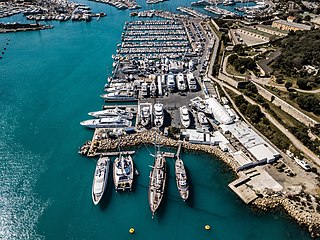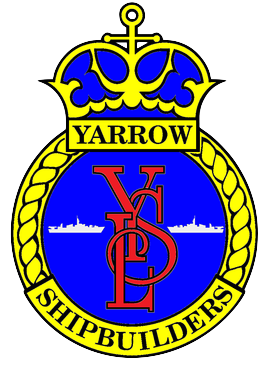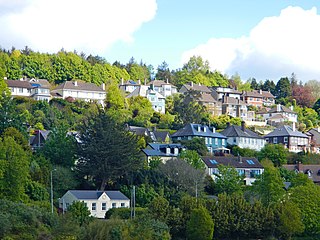Related Research Articles

A shipyard, also called a dockyard or boatyard, is a place where ships are built and repaired. These can be yachts, military vessels, cruise liners or other cargo or passenger ships. Compared to shipyards, which are sometimes more involved with original construction, dockyards are sometimes more linked with maintenance and basing activities. The terms are routinely used interchangeably, in part because the evolution of dockyards and shipyards has often caused them to change or merge roles.
The N8 road is a national primary road in Ireland, connecting Cork with Dublin via the M7. The N8 is further classified by the United Nations as the entirety of the European route E 201, part of the trans-Europe International E-road network. The road is motorway standard from junction 19 on the M7 to the Dunkettle interchange in Cork City and is designated as the M8 motorway. From here the route continues into Cork city centre and terminates at the N22 road at St. Patrick's Street. The M8 motorway was completed in May 2010, replacing the single carriageway sections of the old N8 and bypassing towns on the main Cork to Dublin road. It is now possible to travel from Cork to Dublin on the M/N8 in about 2 hours 30 minutes. The route commences just south of Portlaoise, and reaches Cork via the midlands and the Golden Vale, through counties Laois, Kilkenny, Tipperary, Limerick and Cork.

Cobh, known from 1849 until 1920 as Queenstown, is a seaport town on the south coast of County Cork, Ireland. With a population of 14,418 inhabitants at the 2022 census, Cobh is on the south side of Great Island in Cork Harbour and home to Ireland's only dedicated cruise terminal. Tourism in the area draws on the maritime and emigration legacy of the town.

Sir John Rennie FRSA was the second son of engineer John Rennie the Elder, and brother of George Rennie.

Cork Harbour is a natural harbour and river estuary at the mouth of the River Lee in County Cork, Ireland. It is one of several which lay claim to the title of "second largest natural harbour in the world by navigational area". Other contenders include Halifax Harbour in Canada, Trincomalee Harbour in Sri Lanka and Poole Harbour in England.

Great Island is an island in Cork Harbour, at the mouth of the River Lee and close to the city of Cork, Ireland. The largest town on the island is Cobh. The island's economic and social history has historically been linked to the naval, ship-building, and shipping activities in the town's environs.

Yarrow Shipbuilders Limited (YSL), often styled as simply Yarrows, was a major shipbuilding firm based in the Scotstoun district of Glasgow on the River Clyde. It is now part of BAE Systems Surface Ships, owned by BAE Systems, which has also operated the nearby Govan shipyard since 1999.

Kent Station is an Iarnród Éireann railway station in Cork, Ireland. Originally opened in 1893, the station operates as a hub for Intercity services to Dublin and Tralee and commuter services to Mallow, Cobh and Midleton. In 2016, Kent Station was the fifth busiest station in the Republic of Ireland, as well as the busiest outside of Dublin.

A tide mill is a water mill driven by tidal rise and fall. A dam with a sluice is created across a suitable tidal inlet, or a section of river estuary is made into a reservoir. As the tide comes in, it enters the mill pond through a one-way gate, and this gate closes automatically when the tide begins to fall. When the tide is low enough, the stored water can be released to turn a water wheel.

Robert Day (1836–1914) was an Irish antiquarian and photographer who collaborated with Franz Tieze in producing imitation Williamite, Jacobite and Irish Volunteer glassware.

Little Island, County Cork, is a civil parish and mainly industrial area to the east of Cork city in Ireland. It is no longer an island since the northern channel separating it from the mainland has filled over. To the west and south is Lough Mahon, part of Cork Harbour; across a channel to the east is Fota Island. Little Island is within the Dáil constituency of Cork North-Central.

The R639 road is one of Ireland's regional roads. Once designated the N8 national primary road, it was reclassified in stages as the R639 following the progressive opening of sections of the M8 motorway, which rendered the single carriageway N8 redundant as a national primary road. By-passed sections of the old N8 were generally reclassified as R639 as soon as a new section of M8 opened, thereby increasing the length of the R639. With the completion of the M8 on 28 May 2010, the R639 now stretches from Durrow, County Laois to Cork, running through counties Laois, Kilkenny, Tipperary, Limerick and Cork.

The Ballincollig Royal Gunpowder Mills was one of three Royal gunpowder mills that manufactured gunpowder for the British Government. Located in Ballincollig, Cork city, Ireland, largely in what is now the Ballincollig Regional Park, the powder mills were originally opened in 1794 as a private enterprise, before being taken over by the British Government during the Napoleonic Wars.

The M8 motorway is an inter-urban motorway in Ireland, which forms part of the motorway from the capital Dublin to Cork city. The 149 km motorway commences in the townland of Aghaboe, County Laois and runs through the counties of Kilkenny, Tipperary and Limerick, terminating at the Dunkettle interchange in Cork City. First called for in the Road Needs Study (1998), it was later incorporated into the National Development Plan (2000–2006) and later still formed part of the Irish Government's Transport 21 plan for infrastructural development. The majority of the M8 (115 km) was built between 2006 and 2010. On 28 May 2010, the motorway was completed and had replaced almost all of the single-carriageway N8 except for a short section of urban road in Cork City.

Oliver Piper (1884–1933) was a rugby union international who represented Ireland from 1909 to 1910.

Tivoli is an eastern suburb of Cork in Ireland. Tivoli is in the Dáil constituency of Cork North-Central. A station on the former Cork and Youghal Railway served the area between the 1860s and 1930s.
Joseph Denis Nunan was an Irish born patriot and builder transported to Fremantle for wounding a policeman. He became an architect and building contractor involved in significant buildings in Perth, Fremantle and York. He never gave up his Fenian beliefs and died before he could return to Ireland.
Marchioness Wellesley was a packet paddle steamer launched in 1826 for the Dublin and Wexford Steam Co. She may have been the first steamship built in Ireland. She operated out of Dublin and was last listed in 1838.

Bethlehem Beaumont Shipyard was a shipyard in Beaumont, Texas that opened in 1948. The yard is located on an island in the Neches River and upstream of the Sabine Pass that grants access to the Gulf of Mexico. The deep-water port shipyard was founded in 1917 as the Beaumont Shipbuilding & Dry Dock Company. Beaumont Shipbuilding & Dry Dock Company started as a World War I Emergency Shipbuilding Program yard.

The Cork railway tunnel is a railway tunnel in Cork, Ireland. The 1.2-kilometre (0.75 mi) tunnel was built between 1847 and 1855 and runs from Blackpool to Kent Station on the Lower Glanmire Road. It is the longest operational rail tunnel in Ireland, and is included on the Record of Protected Structures maintained by Cork City Council.